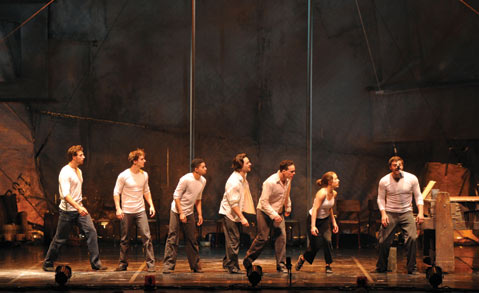A Review of Traces
Canadian Circus Company at the Granada

The human body is a wonder, and maybe no part more than the hand: that extremity we use to sense and to manipulate the world around us, and to leave our mark. How apt, then, that this exquisite nouveau cirque company should name itself Les 7 Doigts de la Main — The 7 Fingers of the Hand. These young artists achieve levels of agility, strength, and coordination that might seem superhuman were they not presented with such humanity.
Last Sunday afternoon at the Granada, the six men and one woman of 7 Fingers performed Traces, a loosely narrative production based around a range of acrobatic feats and physical tours de force: from hand-to-hand balancing and aerial straps to ingenious use of skateboards, chairs, and basketballs. After an explosive opening — flashing lights and flying bodies — a single microphone descended on a wire. One by one the out-of-breath performers announced themselves: name, year of birth, weight, height. Standing bare-faced on the stage in dark trousers and white shirts, they presented themselves with startling simplicity.
There’s a lot to overcome for a contemporary circus company: generations of painted clowns, dressed-up elephants, and tightrope walkers beneath the big tent have primed audiences to expect a certain style of entertainment — one that’s predictable in its remoteness, which alienates and excites in equal measure. With Traces, 7 Fingers rejected that model, instead blending defiant fearlessness and generous humor with slow moments of vulnerability that drew the audience close. A headfirst slide down a pole with no hands elicited gasps, sure. But when Valerie drew a heart on Mathieu’s shirt, then split it with a jagged line, we were equally enthralled. Much of the magic of Traces was in the delicate timing — both the mounting of tension (“They can’t possibly jump higher, can they? Yes, they can!”) and the judicious use of the dramatic pause.
Against an abstract urban backdrop, these seven artists set out to explore the possibilities for interplay between body and environment. Whether slaloming between bottles on rollerblades or using an armchair as a dance partner, they engaged in the kind of play innate to all of us in childhood. “Mom!” cried a small voice behind me at one point, “I could do that!”
At key moments, Traces made use of closed-circuit television, projecting real-time aerial views of the stage as if to remind the viewer that the plush seats of the theater were not the only perspective, and making the stage accessible. Of all the troupe’s feats, this was the most impressive: that the performers transcended the paradigm of the circus trick to make each moment a human act.



